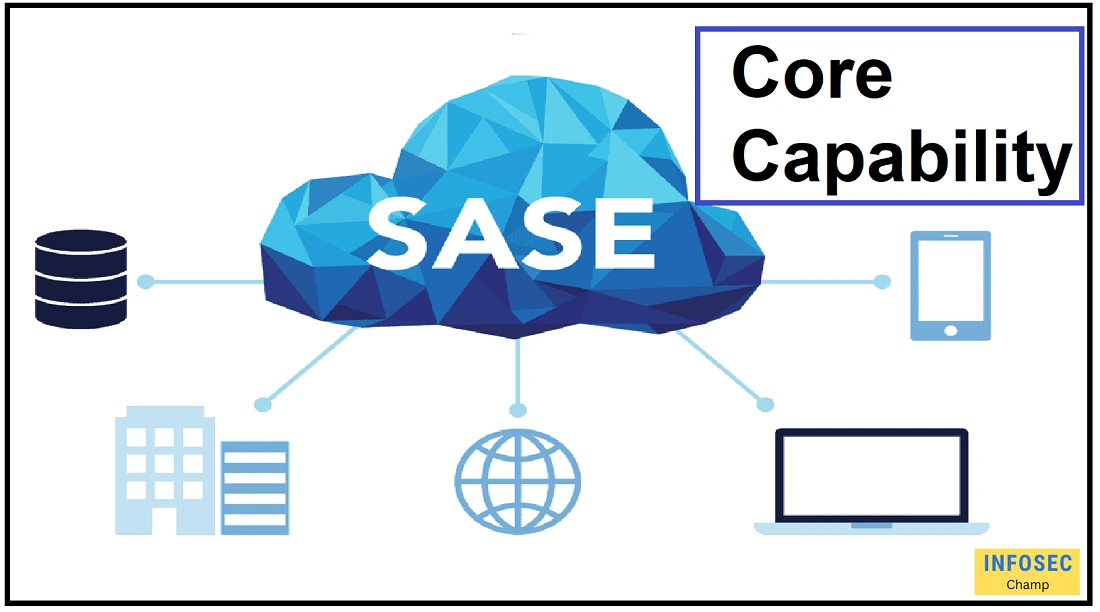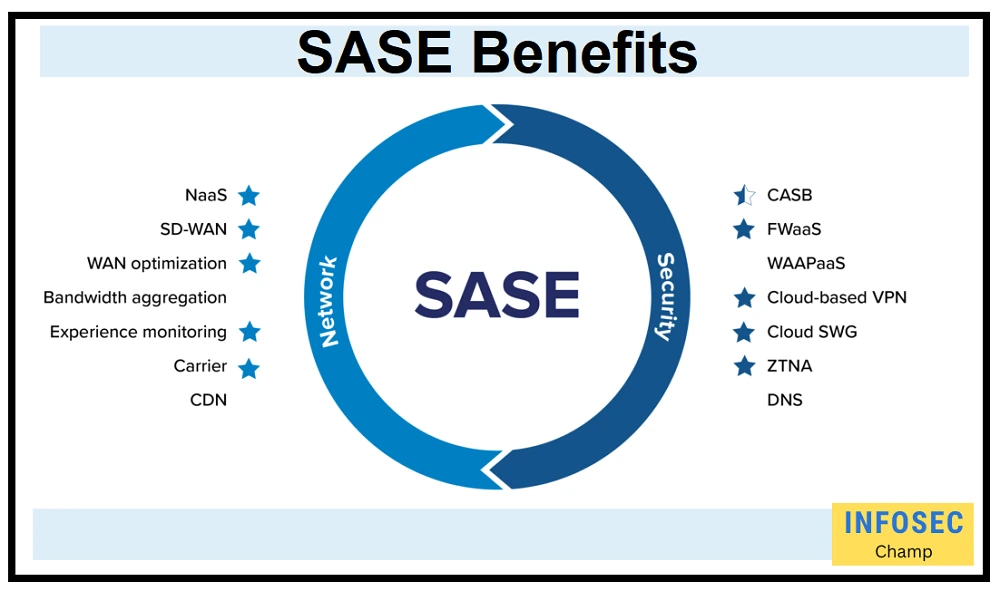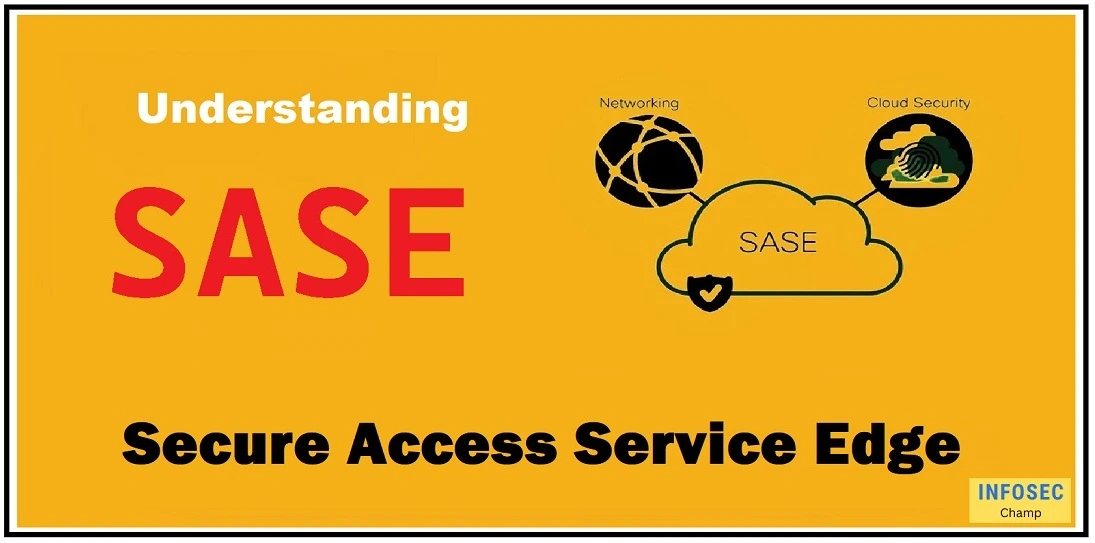SASE stands for Secure Access Service Edge. It is a network architecture that combines security functions such as firewalls, VPNs, and intrusion prevention with wide area networking (WAN) and cloud services. The goal of SASE is to make sure that users and devices can connect to applications and data from anywhere and over any network in a safe and reliable way.
The goal of SASE is to make network security and WAN connectivity easier to manage and maintain by centralizing and simplifying them. It is used a lot in modern organizations with a dispersed workforce that use cloud-based apps and services.
What is SASE and how does it work?
SASE is a network architecture that integrates wide area networking (WAN), cloud services, and security features to provide users and devices access to applications and data over any network in a secure and dependable manner. By centralising and simplifying their utilisation, SA-SE intends to make network security and WAN connection easier to manage and maintain.
Firewalls, VPNs, intrusion detection systems, and load balancing are just a few of the networking and security features that SA-SE often combines on a single cloud-based platform. To use this platform, people and devices are connected to it via a software-defined wide area network (SD-WAN). The platform then directs traffic to the appropriate programmes and services, providing users and equipment with dependable and safe connections.
SA-SE can be configured in a variety of ways, such as as a standalone service or as a component of a hybrid architecture that mixes on-premises and cloud-based components. Modern businesses that depend on cloud-based apps and services and have a scattered workforce frequently employ it.

What are the 5 Core Capabilities of SASE? | What are the 5 key components of SASE?
Several significant skills are commonly linked to SA-SE. In SA—SE solutions, the following five fundamental skills are typically present:
- Wide area networking (WAN): SASE offers networking and connection features that let people and devices access data and applications from any location and over any network. In addition to more seasoned WAN technologies like MPLS and WANs built on the internet, this can also incorporate more modern WAN technologies like software-defined WAN (SD-WAN).
- Security: SA-SE has a number of security measures, including firewalls, VPNs, intrusion protection, and other barriers. Normally, all of these functions are included into a single cloud-based platform that is accessible over the SA-SE network.
- Cloud connectivity: SASE systems are designed to provide secure connectivity to cloud-based applications and services. This can include upport for both public clouds like Amazon Web Services (AWS) and Microsoft Azure as well as private and hybrid cloud systems.
- Identity and access management: SASE solutions usually include capabilities for regulating user identities and access to information and applications. This is known as identity and access management. To assist ensure safe access to resources, support for single sign-on (SSO) and multi-factor authentication (MFA) can be added to this.
- Network optimization and performance: SA-SE solutions are designed to increase network effectiveness and make sure that users’ devices have dependable connectivity to the resources they need. Features like load balancing, traffic shaping, and network monitoring may be utilised to ensure the network operates efficiently.
Is SASE firewall?
The SASE (Secure Access Service Edge) architecture, which is a network architecture that combines security functions with wide area networking (WAN) and cloud services to provide secure and reliable connectivity for users and devices accessing applications and data from anywhere, over any network, heavily relies on firewalls as one of its key components.
Firewalls are typically included in a single cloud-based platform that is accessible through the SA-SE network in an SA-SE architecture. This platform is in charge of directing traffic to the proper programmes and services and of offering security features like firewalls to guard against online dangers.
Firewalls can be used in an SA-SE architecture to regulate network traffic entering and leaving the system based on previously established security criteria. They can be configured to allow or block communication according on a variety of factors, including the traffic’s origin and destination, type, port, and protocol configuration. Firewalls can perform a number of security tasks in an SA-SE architecture, including preventing intrusions, safeguarding against malware, and halting data loss.
Is SASE software?
SASE (Secure Access Service Edge) is a network architecture rather than a single software solution that integrates security features with wide area networking (WAN) and cloud services to offer users and devices access to applications and data over any network in a secure and reliable manner. In order to make network security and WAN connectivity easier to administer and maintain, SA-SE strives to consolidate and simplify them.
Hardware and software are commonly used to implement SASE solutions. Networking hardware for an SA-SE solution could consist of firewalls, switches, and routers. Numerous security and networking features, including firewalls, VPNs, intrusion prevention, load balancing, and traffic shaping, may be included in the software component. In a cloud setting, SA-SE solutions are frequently sold as a service, with the service provider handling the hardware and software components.
Why do we use SASE? | Why SASE is the future?
Organizations may decide to utilise SA-SE (Secure Access Service Edge) as their network architecture for a number of reasons:
- Improved security: To defend against online threats, SASE solutions include a variety of security features like firewalls, VPNs, and intrusion prevention. Typically, all of these features are combined into a single cloud-based platform that can be accessible through the SASE network.
- Simplified network management: Network management is made easier thanks to SASE solutions, which are meant to consolidate and streamline network security and WAN connection. This can be especially helpful for businesses that employ cloud-based services and applications and have a scattered workforce.
- Improved network performance: SASE solutions are created to enhance network performance and make sure that users and devices have dependable connectivity to the resources they require. This results in an improvement in network performance. For the network to run smoothly and effectively, capabilities like load balancing, traffic shaping, and network monitoring may be used.
- Increased flexibility: SASE solutions are made to link users and devices to applications and data across any network in a secure and dependable manner. Organizations with distributed workforces that need to access resources from a range of places and devices may find this to be very helpful.
- Reduced costs: SA-SE solutions can assist enterprises in lowering the costs related to operating and maintaining a complex network infrastructure by centralising network security and WAN connectivity in a single, cloud-based platform.
Top 12 SASE vendors | SASE companies
There are several vendors and companies that offer SASE (Secure Access Service Edge) solutions. Some examples include:
- Netskope: Provides a cloud-based SASE platform that includes security and networking functions such as VPN, firewall, and content filtering.
- Zscaler: Offers a cloud-based SASE platform that includes security and networking functions such as firewall, VPN, and web security.
- Cloudflare: Provides a cloud-based SASE platform that includes security and networking functions such as web application firewall (WAF), content delivery network (CDN), and DDoS protection.
- Barracuda Networks: Offers a cloud-based SASE platform that includes security and networking functions such as firewall, VPN, and web security.
- VMware: Provides a cloud-based SASE platform that includes security and networking functions such as firewall, VPN, and web security.
- Fortinet: Offers a cloud-based SASE platform that includes security and networking functions such as firewall, VPN, and web security.
- Palo Alto Networks: Provides a cloud-based SASE platform that includes security and networking functions such as firewall, VPN, and web security.
- Akamai: Offers a cloud-based SASE platform that includes security and networking functions such as firewall, VPN, and web security.
- Cisco: Provides a cloud-based SASE platform that includes security and networking functions such as firewall, VPN, and web security.
- Cato SASE: Offers a cloud-based SASE platform that includes security and networking functions such as firewall, VPN, and web security.
- Perimeter 81: Provides a cloud-based SASE platform that includes security and networking functions such as firewall, VPN, and web security.
- Twingate: Offers a cloud-based SASE platform that includes security
SASE Cisco
A SASE (Secure Access Service Edge) platform named Cisco SD-WAN is offered by Cisco, a well-known provider of networking and security solutions. Users and devices accessing apps and data from any location across any network can connect securely and reliably with Cisco SD-WAN. It features a variety of security features, including WAN connectivity, cloud connectivity, firewalls, VPNs, and intrusion prevention.
The hardware and software components of Cisco SD-WAN are maintained by Cisco in a cloud environment, and it is provided as a service. It can be used either independently as a solution or as a component of a hybrid architecture that mixes elements from on-premises and the cloud. Organizations with a scattered workforce that depend on cloud-based apps and services frequently employ Cisco SD-WAN.
SASE Cloudflare
Cloudflare provides internet security, performance, and dependability solutions. The company offers Cloudflare One, a SASE (Secure Access Service Edge) solution designed to give users and devices secure, dependable access to apps and data across any network.
Cloudflare One comes with WAN connectivity, cloud connectivity, and a multitude of security features like firewalls, VPNs, and intrusion prevention. The hardware and software components are managed by Cloudflare in a cloud environment, and it is offered as a service. Cloudflare One can be used as a standalone solution or as a part of a hybrid architecture that combines on-premises and cloud-based components. Businesses with a scattered workforce and a reliance on cloud-based software and services commonly use it.
SASE Gartner
Leaders in the business and technology sectors can get insights, counsel, and tools from Gartner, a research and consultancy company. SASE (Secure Access Service Edge) has been identified by Gartner as a significant trend in networking and security and has been the subject of published research.
In order to provide users and devices with safe and dependable connectivity for accessing applications and data from any location across any network, Gartner describes SA-SE as a network architecture that blends security functions with wide area networking (WAN) and cloud services. In order to make network security and WAN connectivity easier to administer and maintain, SA-SE strives to consolidate and simplify them.
Wide area networking, security, cloud connection, identity and access management, and network performance and optimization are a few of the major features that Gartner has highlighted as commonly being present in SA-SE solutions. The company has also identified a number of important factors that are influencing the adoption of SASE, such as the requirement to offer dependable and secure connectivity for a dispersed workforce, the growing reliance on cloud-based software and services, and the desire to centralise and streamline network security and WAN connectivity.
SASE architecture
In order to provide users and devices with secure and dependable connectivity for accessing applications and data from any location over any network, the SASE (Secure Access Service Edge) network architecture combines security functions with wide area networking (WAN) and cloud services.
Security tools like firewalls, VPNs, and intrusion prevention are generally combined into a single, cloud-based platform in a SASE architecture and accessible through the SA-SE network. This platform is in charge of directing traffic to the proper programmes and services and of offering security features to guard against online dangers.
A software-defined wide area network (SD-WAN) is often used in a SASE architecture to link users and devices to the SA-SE platform. Traffic must be directed to the right resources in order for the SD-WAN to maximise network performance.
SASE solutions can be used in a variety of deployment scenarios, such as standalone services or hybrid architectures that integrate on-premises and cloud-based components. Modern businesses that use cloud-based applications and services and a distributed workforce frequently adopt SA-SE.

Top 25 SASE benefits
There are several benefits to using a SASE (Secure Access Service Edge) solution, including:
- Secure and reliable connectivity: SASE solutions are designed to provide secure and reliable connectivity for users and devices accessing applications and data from anywhere, over any network.
- Simplified and centralized management: SA-SE solutions are designed to simplify and centralize network security and WAN connectivity, making it easier to manage and maintain the network.
- Improved security: SASE solutions include a range of security functions such as firewalls, VPNs, and intrusion prevention that are designed to protect against cyber threats.
- Enhanced productivity: By providing secure and reliable connectivity, SA-SE solutions can help improve the productivity of users and devices accessing applications and data.
- Flexibility and scalability: SA-SE solutions are highly flexible and scalable, making it easy to add or remove users and devices from the network as needed.
- Reduced complexity: SA-SE solutions are designed to simplify and centralize network security and WAN connectivity, reducing the complexity of the network.
- Cost savings: SASE solutions can help organizations reduce the costs associated with managing and maintaining the network, as well as the costs of cyber threats.
- Improved network performance: SA-SE solutions are designed to optimize network performance and ensure that users and devices have reliable connectivity to the resources they need.
- Cloud connectivity: SASE solutions are designed to provide secure connectivity to cloud-based applications and services, making them well-suited for organizations that rely on the cloud.
- Support for a distributed workforce: SA-SE solutions are well-suited for organizations with a distributed workforce that relies on cloud-based applications and services. They provide secure and reliable connectivity for users and devices accessing applications and data from anywhere, over any network.
- Improved user experience: SA-SE solutions are designed to provide a seamless and consistent user experience across different devices and locations, improving the overall user experience.
- Enhanced mobility: SASE solutions enable users to access applications and data from any device and location, improving mobility and flexibility.
- Improved collaboration: SASE solutions enable users to collaborate and share data in real-time
- Enhanced visibility and control: SA-SE solutions provide organizations with enhanced visibility and control over the network and can help identify and mitigate potential security risks.
- Improved compliance: SASE solutions can help organizations meet regulatory compliance requirements and reduce the risk of data breaches.
- Integration with other security technologies: SAS-E solutions can be integrated with other security technologies such as identity and access management (IAM) and threat intelligence platforms to provide a more comprehensive security posture.
- Support for hybrid environments: SA-SE solutions can support hybrid environments that combine on-premises and cloud-based components, providing flexibility and scalability.
- Enhanced data protection: SA-SE solutions can help protect sensitive data by encrypting data in transit and at rest, helping to prevent data breaches and unauthorized access to sensitive information.
- Improved business continuity: SA-SE solutions can help ensure business continuity by providing secure and reliable connectivity to applications and data even in the event of a network outage or disruption.
- Enhanced agility and flexibility: SA-SE solutions enable organizations to quickly and easily scale the network up or down as needed, improving agility and flexibility.
- Improved network performance and reliability: SA-SE solutions are designed to optimize network performance and ensure that users and devices have reliable connectivity to the resources they need.
- Improved network efficiency: SASE solutions can help organizations reduce network complexity and improve network efficiency by simplifying and centralizing network security and WAN connectivity.
- Reduced hardware and maintenance costs: SA-SE solutions can help organizations reduce hardware and maintenance costs by leveraging cloud-based components and managed services.
- Improved security posture: SASE solutions can help organizations improve their security posture by providing a range of security functions such as firewalls, VPNs, and intrusion prevention, as well as enhanced visibility and control over the network.
- Enhanced disaster recovery: SA-SE solutions can help organizations improve their disaster recovery capabilities by providing secure and reliable connectivity to applications and data in the event of a network outage or disruption.
What is the difference between SASE and WAF?
Both WAF (Web Application Firewall) and SASE (Secure Access Service Edge) are technologies that can be used to secure networks and applications. Here is a basic comparison of how the two differ:
- Scope of functionality: SASE is a network architecture that combines security functions with wide area networking (WAN) and cloud services to offer users and devices accessing applications and data from any location over any network with safe and dependable
- Connectivity. A special type of security technology called a WAF is employed to defend web applications from online dangers like hacking, injection attacks, and cross-site scripting.
- Deployment model: Model of deployment: SASE systems are often provided as a service, with the service provider managing the hardware and software elements in a cloud setting. WAFs can be set up locally or in the cloud, and they can be administered by the company itself or by a different service.
- Level of integration: SASE solutions integrate several security and networking tasks into a single, cloud-based platform in order to centralise and simplify network security and WAN connection. In most cases, WAFs are employed as a stand-alone technique to secure web applications.
- Level of control: With SASE, the service provider frequently has greater influence over networking and security operations while with WAF, the business frequently has more influence over security operations.
In conclusion, WAF is a particular security technique used to defend web applications from cyber attacks, whereas SASE is a more comprehensive network design that encompasses a variety of networking and security functions. While WAFs can be deployed on-premises or in the cloud and are concentrated on protecting web applications, SASE solutions are often supplied as a service and are intended to simplify and centralise network security and WAN connection.
SASE Fortinet | Vmware SASE | Zscaler SASE
SASE (Secure Access Service Edge) solutions are provided by Fortinet, VMware, and Zscaler, while a SASE platform is provided by the cloud security company Zscaler. An outline of these options is provided below:
- Fortinet: The SA-SE solutions offered by Fortinet, a market leader in network security, combine security, networking, and cloud functionality into a single, cloud-based platform.
- VMware: A well-known supplier of virtualization and cloud infrastructure solutions, VMware also provides an SA-SE solution referred to as VMware SD-WAN. Users and devices accessing apps and data from any location across any network can connect securely and reliably with VMware SD-WAN. It features a variety of security features, including WAN connectivity, cloud connectivity, firewalls, VPNs, and intrusion prevention.
- Zscaler: Leading supplier of cloud security solutions Zscaler also provides an SA-SE platform called Zscaler Private Access (ZPA). ZPA is intended to offer users and devices access to applications and data over any network in a secure and dependable manner. It comes with a variety of security features like WAN and cloud connectivity, firewalls, VPNs, and intrusion prevention.
FAQ:
1. Is SASE a cloud service?
In order to provide users and devices with secure and dependable connectivity for accessing applications and data from any location over any network, the SASE (Secure Access Service Edge) network architecture combines security functions with wide area networking (WAN) and cloud services. In this regard, SA-SE is comparable to a cloud service because it depends on cloud-based components to offer networking and security features.
SASE systems are often provided as a service, with the service provider managing the hardware and software parts in a cloud setting. In other words, businesses don’t have to manage and maintain the hardware and software components themselves in order to use the SA-SE platform and its features online.
SASE solutions can be used in a variety of deployment scenarios, such as standalone services or hybrid architectures that integrate on-premises and cloud-based components. Modern businesses that utilise cloud-based software and services and a distributed workforce frequently use SASE.
2. How SASE is different from VPN? | Does SASE use a VPN?
SASE (Secure Access Service Edge) and VPN (Virtual Private Network) are both technologies that can be used to provide secure and reliable connectivity for users and devices accessing applications and data from anywhere, over any network. However, there are some key differences between the two technologies:
- Scope of functionality: SA-SE is a broad network architecture that combines security functions with wide area networking (WAN) and cloud services, while VPN is a specific technology that is used to create a secure, encrypted connection between two or more devices.
- Deployment model: SA-SE solutions are typically delivered as a service, with the hardware and software components managed by the service provider in a cloud environment. VPNs, on the other hand, can be deployed on-premises or in the cloud and may be managed by the organization or by a third-party provider.
- Level of integration: SA-SE solutions are designed to simplify and centralize network security and WAN connectivity, with a range of security and networking functions integrated into a single, cloud-based platform. VPNs, on the other hand, are typically deployed as a standalone technology that is used to create a secure connection between two or more devices.
- Level of control: With SA-SE, the service provider typically has more control over the security and networking functions, while with VPN, the organization typically has more control over the security and networking functions.
In summary, SA-SE is a broader network architecture that includes a range of security and networking functions, while VPN is a specific technology used to create a secure connection between two or more devices. SA-SE solutions are
3. Is SASE and SD-WAN the same?
In order to provide users and devices with secure and dependable connectivity for accessing applications and data from any location over any network, the SASE (Secure Access Service Edge) network architecture combines security functions with wide area networking (WAN) and cloud services. A secure, encrypted connection between two or more devices is established using the VPN (Virtual Private Network) technology.
A VPN component could be a part of SASE solutions’ security features that are built into the SA-SE platform. When accessing applications and data over the internet, VPNs can be used to defend against cyber dangers by establishing a secure connection between users’ devices and the SA-SE platform.

